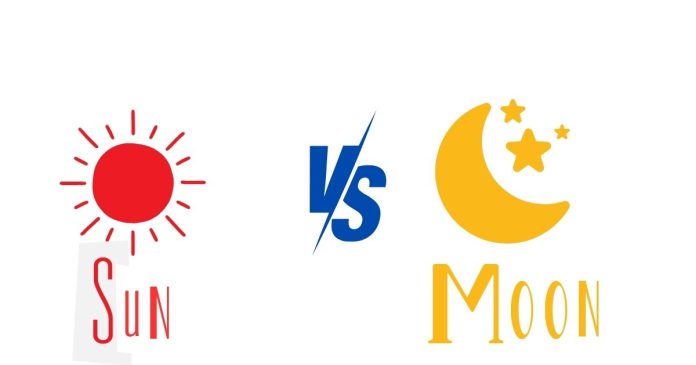The Sun and the Moon are two celestial bodies that are essential to life on Earth. They appear similar in size when viewed from Earth, but they are vastly different in terms of their composition, function, and significance. While the Sun is a massive star at the center of our solar system, the Moon is Earth’s only natural satellite. In this article, we’ll explore the differences between the Sun and the Moon and their roles in our universe.
The Sun: A Star That Powers Life
The Sun is a hot, glowing ball of gas made primarily of hydrogen and helium. It is a star and the central point of the solar system, around which all planets, including Earth, revolve.
Key Facts About the Sun:
- Size and Distance:
- Diameter: About 1.39 million kilometers.
- Distance from Earth: Approximately 149.6 million kilometers (93 million miles).
- Composition:
- The Sun is made up of hot plasma with nuclear fusion occurring at its core, where hydrogen atoms fuse to form helium, releasing energy.
- Energy Source:
- The Sun is the primary source of light and heat for Earth, driving weather patterns, the water cycle, and photosynthesis.
- Role in the Solar System:
- Its gravity keeps planets, moons, asteroids, and comets in orbit.
- Brightness:
- The Sun emits its own light and is the brightest object in the daytime sky.
The Moon: Earth’s Companion
The Moon is a rocky, airless body that orbits Earth. It is much smaller than the Sun and does not produce its own light. Instead, it reflects sunlight.
Key Facts About the Moon:
- Size and Distance:
- Diameter: About 3,474 kilometers.
- Distance from Earth: Approximately 384,400 kilometers.
- Composition:
- The Moon is made of rock and dust, with a crust, mantle, and core. It has many craters formed by asteroid impacts.
- Light:
- The Moon does not emit light. Its glow is the result of sunlight reflecting off its surface.
- Orbit:
- The Moon completes one orbit around Earth every 27.3 days, which is why we see different phases of the Moon.
- Tides:
- The Moon’s gravitational pull is responsible for ocean tides on Earth.
Differences Between the Sun and the Moon
| Feature | The Sun | The Moon |
|---|---|---|
| Type | A star (hot ball of gas). | A natural satellite (rocky body). |
| Size | Much larger (1.39 million km in diameter). | Much smaller (3,474 km in diameter). |
| Light Source | Emits its own light through nuclear fusion. | Reflects sunlight, does not produce light. |
| Distance from Earth | 149.6 million km (much farther). | 384,400 km (much closer). |
| Role | Central to the solar system, powers life. | Affects tides and stabilizes Earth’s axis. |
| Surface | Gaseous surface with no solid crust. | Rocky surface with craters and dust. |
The Sun and the Moon: Similarities
Despite their differences, the Sun and Moon share a few similarities:
- Appear Similar in Size:
- From Earth, they appear to be the same size due to their relative distances. This coincidence allows for solar eclipses to occur.
- Essential for Life on Earth:
- The Sun provides energy for life, while the Moon influences tides, which play a role in ecological balance.
- Cycles:
- Both have predictable cycles (the Sun’s rise and set, and the Moon’s phases) that have guided human activities for centuries.
Cultural and Scientific Significance
- Cultural Importance:
- Many ancient civilizations revered the Sun and the Moon, incorporating them into mythology, religion, and calendars. For example:
- The Sun is often seen as a life-giver (e.g., Ra in Egyptian mythology).
- The Moon is associated with timekeeping and femininity in various cultures.
- Many ancient civilizations revered the Sun and the Moon, incorporating them into mythology, religion, and calendars. For example:
- Scientific Study:
- The Sun is studied in astrophysics to understand stellar life cycles and energy production.
- The Moon has been explored through space missions, including the famous Apollo landings, to understand Earth’s history and the solar system.
The Sun and the Moon may look similar from Earth, but they are vastly different in terms of size, composition, and role in the universe. The Sun is a massive star that sustains life by providing energy, while the Moon is a rocky satellite that influences tides and adds beauty to the night sky. Together, they play crucial roles in maintaining life and balance on Earth, making them both fascinating and indispensable celestial bodies.


